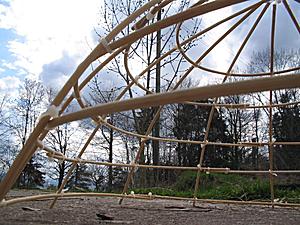  Bow Dome Model, composed by bamboo splits, apprx. 3/8 sphere |
The bow dome goes back to the very first habitat built by humans to shelter himself - composed by flexible and rather thin tree branches, can be thereby considered an archaic form of habitat aside of the tipi.
Bow Dome Types
For a start a few different types of bow domes, derived from the bow bending, tying and assembling:
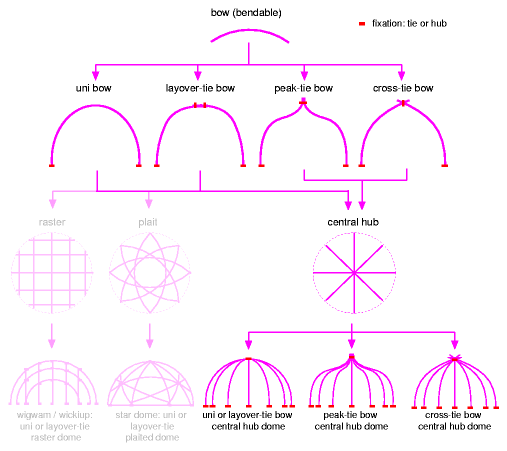 |
The Wigwam and Star Dome are not covered in this section, but have dedicated pages, but according this typology also considered "Bow Domes". This typology is subject of change, as I still search for a common mathematically description for all bow-based domes, which takes in account also the bow tying options as illustrated above. See also the broader overview of Strut/Bow-based Building Typology, and also miscellaneous bow domes models I made.
The Model
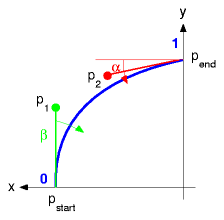 Bow Dome Bezier Curve Model |
I'm using a simple mathematical model based on Bezier curve  with two angles, α and β which define the bending of both ends - it helps to describe the bow domes more precise, and later on this page also a "bow dome calculator" provides the numerical solution for those types, including canvas shapes for a leaf-like composed cover.
with two angles, α and β which define the bending of both ends - it helps to describe the bow domes more precise, and later on this page also a "bow dome calculator" provides the numerical solution for those types, including canvas shapes for a leaf-like composed cover.
- p(x,y) = fbezier(t)
- t = 0 .. 1
- pstart = (1,0) (bottom)
- pend = (0,1) (top)
- p1 = (1-sin(β)*.6,cos(β)*.6)
- p2 = (cos(α)*.6,1-sin(α)*.6)
- fbezier(t) = (1-t)3 pstart + 3 t (1-t)2 p1 + 3 t2 (1-t) p2 + t3 pend
Let's have a look to the different dome approaches with this model.
Half Sphere / Hemisphere / Unibow / Layover-Tie Dome
Both α & β are zero, so the resulting dome is a half sphere.
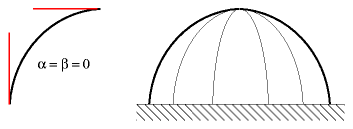 Half Sphere Bow Dome |
This form is the most common and expected, yet, it has some disadvantages, e.g. that the roof angle at the top is almost horizontal. In case of rain or even snow it may not naturally slide or flow away.
So it often is suitable to add another smaller acrylic dome as skylight to avoid these challenges.
Cross-Tie Bow Dome
α is greater than 0°, β can be 0° or positive, or negative, either way it will form a pointy dome.
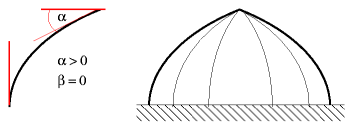 Cross-Tie Bow Dome |
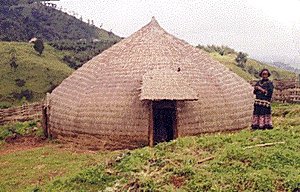 |
An example are the Sidama (Ethiopia highland region) Tukul houses. They are composed by a bamboo split plaitwork, built by specialized handicraft groups.
Peak-Tie Bow Dome
α is greater than 45°, β remains 0.
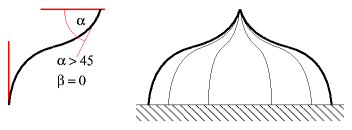 Peak-Tie Bow Dome |
Bell Bow Dome
α is less than 45°, β greater than 45°
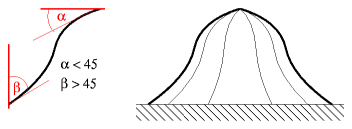 Bell Bow Dome |
Other Types
Anyway, there are more options, as the bow can be bent not just one way (outward or inward), but a combination of both and so more variants are possible, but then also the resulting required cover form becomes quite challenging to plan.
Bending the Bows
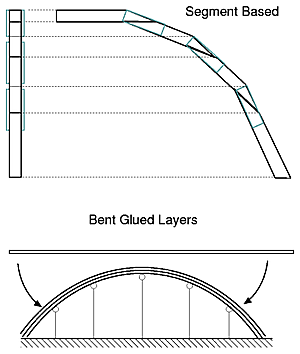  Prefabricated Bows |
Modern bow domes have prefabricated struts composed by
- several segments making up a bent bow, e.g. like the example as shown on the right, 4 segment bow with enforcement strut on left and right side of the composition; or
- multiple layers of thin wooden layers (0.2-0.5 cm) bent and glued together.
Crown & Crownless
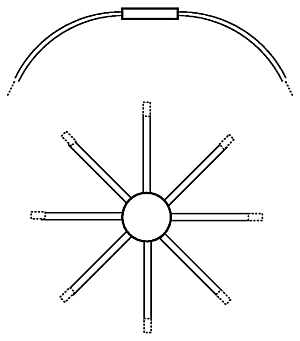 |
As comparison take also a look at the wigwam, where the bows have different diameters, and are bound at the intersections, and no crown required.
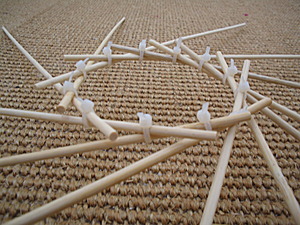 |
On the next page, where I documented making models, you will find more photos of this "crownless" bow dome model.
Canvas
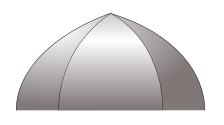 |
Symbols & Formulas
 |
| y = 0 .. h | cy = ry * 2 * π | h = fh(α,β,r) |
| ynorm = y / h | cys = cy / nleaves | ry = fr(α,β,ynorm) |
fr(α,β,ynorm) is different for each dome type, for a half-sphere dome:
- fr(α,β,ynorm) = cos( ynorm * 90 ) * r
- fh(α,β,r) = r * 2 * π / 4
For a general approach I simplified it using Bezier curve to simulate the bending of a bow. Industrial manufactured bows are done via wooden segments, the following Bow Dome Calculator gives you the exact measurements also to construct the bend bow via segments. In case you use natural bending materials, you may still have to calculate your canvas by hand by measuring each radius at a given height (refere the illustrations above).
Bow Dome Calculator
Edit diameter d, height h, amount of leaves of the cover nleaves and the two angles α and β, and then hit "calculate".